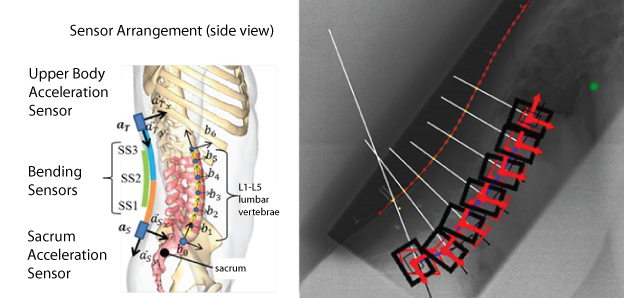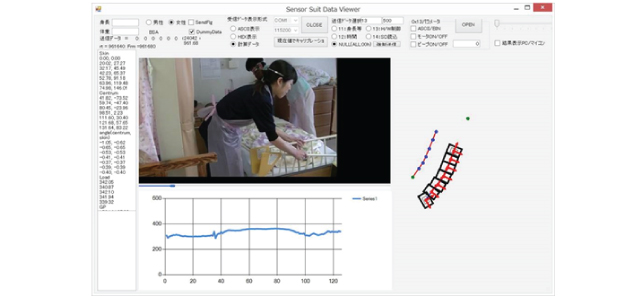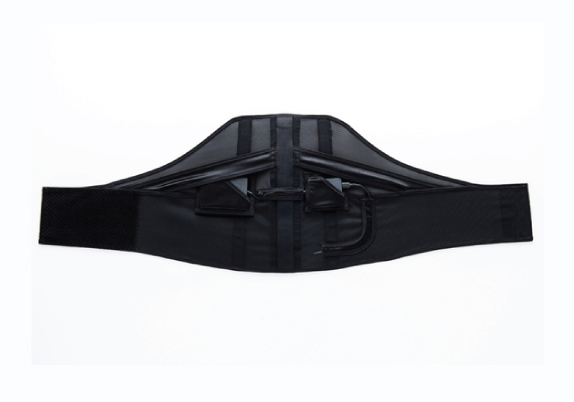Wearable Sensor Visualizes Waist Load
Research Press Release | October 05, 2015
-
 Sensor Configuration and Estimated Results for Lumbosacral Spine Alignment: Using a group of sensors arranged on the back can non-invasively estimate the lumbar shape, similarly to what an X-ray image does. (left: sensor configuration, right: X-ray image results (red) and estimated results (black))
Sensor Configuration and Estimated Results for Lumbosacral Spine Alignment: Using a group of sensors arranged on the back can non-invasively estimate the lumbar shape, similarly to what an X-ray image does. (left: sensor configuration, right: X-ray image results (red) and estimated results (black)) -
 Measurement Results of the Load on the Lumbar Region In Demonstrations: While estimating the lumbar shape from posture measurement (above figure, right), by estimating the load on the lumbar region based on a musculoskeletal dynamics model (above figure, blue line in the graph), it can give a warning in real time about a dangerous posture.
Measurement Results of the Load on the Lumbar Region In Demonstrations: While estimating the lumbar shape from posture measurement (above figure, right), by estimating the load on the lumbar region based on a musculoskeletal dynamics model (above figure, blue line in the graph), it can give a warning in real time about a dangerous posture.
| Press Release | ||
|---|---|---|
| Key Points | ・Through joint research with Nikon Corporation, Hokkaido University has developed a wearable sensor (embedding accelerometers and multiple bending sensors), as an application of sensing technology.
・ From various sensing results, it can estimate the posture and the load around the waist. ・ Lightweight, and easy to take on and off, it can be worn like clothing. ・ Demonstrations were performed at nursing homes, and it succeeded in measuring the load on the waists of care workers. ・By accumulating and analyzing the sensing data, a reduction on waist load and optimization of personnel allocation is expected to lead to work improvements and promote development of this product. ・ Aims to present products and services that can be used in nursing homes and other workplaces. |
|
| Overview |
A wearable sensor was developed by embedding multiple sensors so that loads on the waist are made visible just by putting it on. From the information obtained by acceleration sensors and bending sensors, a newly developed method can estimate the alignment, i.e. the position and posture, of the lumbosacral spine and the load on the lumbar vertebrae. This method has successfully measured the loads on the lumber spine of care workers at nursing homes. In the future, considering the development of products and services that can be used in nursing homes and other workplaces, we plan to pursue development in order to present solutions that lead to work improvements, such as reducing the load on the waist and optimizing personnel allocation, by accumulating data on the load on the waist during work, and performing big data analysis. Wearable Sensor (top: general view, bottom: when actually worn) |
|
| Inquiries |
Takayuki TANAKA, Associate Professor, Graduate School of Information Science and Technology, Hokkaido University TEL & FAX: +81-11-706-6756 E-mail: info@ssc.ssi.ist.hokudai.ac.jp |
|
|
Japanese Link |
着るだけで腰の負担が見えるセンサ内蔵ウェアの開発に成功 (2015.9.9) | |
|
Publications |
医療・介護支援のためのロボット技術と軽労化技術 , The 57th Congress of All Japan Hospital Association (2015.9.12) | |


